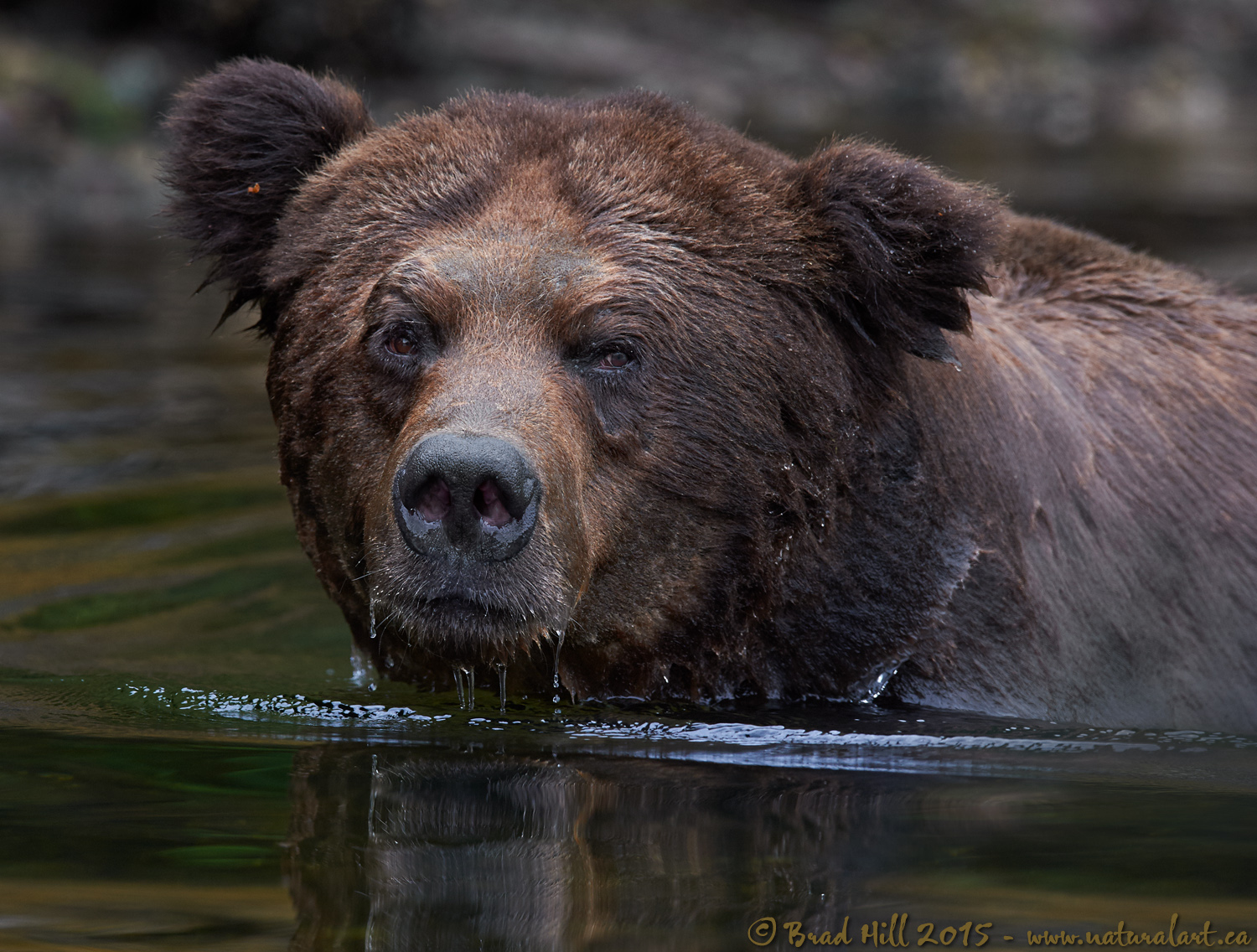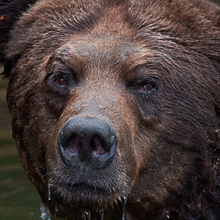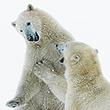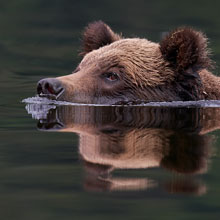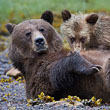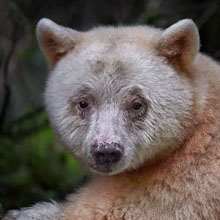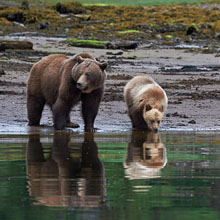Availability: Undetermined - Enquiries?
In the Field
Three Decades of Influence. Khutzeymateen Grizzly Sanctuary, northern BC coast, Canada, BC, Canada. May 29, 2013.
Like many apex predators, grizzlies are relatively long-lived animals. This massive male was right around 30 years old when I captured this image. He's probably the most famous grizzly on BC's northern coast - and he's been having a massive impact on the area for the better part of those 3 decades. Some refer to him as Brutus, others call him "The King". And, those who know him well like to reverentially refer to him by a more familiar name - the Big Guy.
During the last couple of decades the Big Guy has dominated the Khutzeymateen. All other bears respect him - and he keeps them honest and absolutely controls the social framework of the entire Khutzeymateen. Of course, in being the dominant male in the area, he has been doing the lion's share of the breeding in the valley, producing "Little Guys" (and Little Girls!) that carry his powerful spirit and his tested, proven, and razor-honed genetic material.
A bear like this attracts two types of humans. The first group includes bear watchers and photographers. This group will pay thousands of dollars to witness and photograph this majestic bear - or ones just like him! And they'll do it year-in and year-out. Most importantly, they'll leave with a new-found or re-discovered respect for the ways of the natural world and just how spectacular a tank-sized apex predator can be!
The second group are trophy-hunters, who target bears just like Brutus - the big ones that have the most social and ecological impact in region. After one visit they'll leave with his head and possibly his paws, leaving his once-noble carcass to rot. Why? Just to brag about what they've done and show off their "trophy".
It's nothing short of ecological nonsense to remove apex predators from an ecosystem - they are the key contributors to ecosystem structure and in the creation and maintenance of biodiversity. And in "managing them" through removing the big, dominant male bears we often create the very problems the "bear management" is designed to prevent. Those who have spent time with this or other grizzlies fully appreciate their sentient - and so often gentle - nature. The ethical makeup of someone who would kill such an animal "for fun" dumbfounds me. There are simply no ecological or ethical grounds to justify the trophy hunting of apex predators.
Those supporting the trophy-hunting of grizzlies (and other apex predators) often resort back to economic arguments - those hunters bring in just so much money and employment to rural areas - right? Wrong! A study out of Stanford University - published in January of 2014 - showed how bear viewing on the coast of BC generated: twelve (12) times more visitor spending than bear hunting; eleven (11) times more revenue for the BC government than bear hunting; and forty-eight (48!!) times more jobs than bear hunting! In fact, bear hunting COSTS the BC government more money than it generates.
Public opinion? In September of 2013 a poll by McAllister Opinion Research found that 87% of British Columbians support a ban on trophy hunting for bears in the Great Bear Rainforest.
Looking for a realistic way to end the trophy hunting of apex predators on BC's coast? Here's the best pathway:
• Purchasing Commercial Hunting Territories
Brutus is even more impressive in high-resolution form - check out this 2400 pixel image of him:
• Three Decades of Influence: Download 2400 pixel image (JPEG: 1.7 MB)
NOTES:
1. This image - in all resolutions - is protected by copyright. I'm fine with personal uses of them (including use as desktop backgrounds or screensavers on your own computer), but unauthorized commercial use of the image is prohibited by law. Thanks in advance for respecting my copyright!
2. Like all wildlife images on this website, the subject is fully wild and completely unconstrained. Besides the potential impact of my presence, nothing has been done to intentionally alter or affect the ongoing behavior of the subject and, of course, there has been no use of any form of bait or other form of wildlife attractants (including vocalizations).
3. This image was captured during one of my two spring "Grizzlies of the Khutzeymateen" photo tours in May/June of 2013. Each year I offer trips into two different parts of the Great Bear Rainforest as well as one to photograph aquatic mammals and oceanscapes near the northern tip of Vancouver Island. And, in selected years, I also offer photo tours to locations to capture other highly sought-after subjects, such as various boreal owl species and wildlife of Canada's Arctic. Details about these trips can be found on the Photo Tours page of this website.
Behind the Camera
Three Decades of Influence. Khutzeymateen Grizzly Sanctuary, northern BC coast, Canada, BC, Canada. May 29, 2013.
Digital Capture; Compressed RAW (NEF) 14-bit format; ISO 1100.
Nikon D4 paired with Nikkor AF-S 400mm f2.8 VR - hand-held from floating Zodiac. VR on in Normal mode.
1/500s @ f8; -0.67 stop compensation from "recommended" matrix-metered exposure setting.
At the Computer
Three Decades of Influence. Khutzeymateen Grizzly Sanctuary, northern BC coast, Canada, BC, Canada. May 29, 2013.
RAW Conversion to 16-bit TIFF Phase One's Capture One Pro 8. Four raw variants (different versions of a single raw capture) processed, differing by a total of 0.5 stops in exposure (as well as differences in highlight and shadow retrieval).
Further digital corrections on resulting 16-bit TIFF files using Adobe's Photoshop CC and Light Crafts Lightzone. Photoshop adjustments included compositing (blending) of the four output files from the raw converter using manual masking techniques, minor exposure and contrast tweaks, selective colour desaturation, and selective sharpening for web output. Final tone-tweaking performed using LightZone's "tonemapper" tool.
Conservation
Three Decades of Influence. Khutzeymateen Grizzly Sanctuary, northern BC coast, Canada, BC, Canada. May 29, 2013.
Ten percent of the revenue generated by this image will be donated to Raincoast*.
Species Status in Canada**: Special Concern (May 2002).
While Grizzly Bears (Ursus arctos) are not technically listed as "Endangered" in Canada, they have been extirpated from most of their historical range. Grizzly Bears are far more sensitive to intrusion/disturbance in their habitat than are Black Bears and are being increasingly forced into marginal habitat by human encroachment. The Great Bear Rainforest along the central and northern coast of British Columbia is one of the last strongholds of the Grizzly Bear in Canada, and even this population is coming under increasing pressure.
On December 18, 2017 the government of British Columbia banned grizzly hunting across the entire province. This major conservation victory came after decades of tireless work by many dedicated conservationists and ecologists and, most importantly, it reflects the opinion of the vast majority of British Columbians. And, it means that AT LEAST while the current government remains in power grizzlies are finally "safe" in British Columbia.
Now that we've at least temporarily won the battle to save grizzlies in BC, it's time to re-focus our efforts toward protecting ALL of BC's carnivores, including Gray Wolves, Black Bears, Cougars, Wolverines, and more! Simply put, there are no ecological, economic, or ethical arguments supporting the trophy hunting of carnivores.
In a great first step towards ending the hunting of carnivores throughout BC the Raincoast Conservation Foundation has developed a program designed to protect ALL carnivores within the Great Bear Rainforest. Details about this program can be found on this page on Raincoast's website. Check it out and, better yet, make a donation to help Raincoast purchase the remaining commercial hunting tenures in the Great Bear!
*The Raincoast Conservation Society (and Foundation) is an effective and efficient organization that has been fighting for protection of this unique habitat. If you are looking for a meaningful way to contribute to the conservation of this amazing ecosystem, Raincoast will provide maximal "bang" for your conservation dollars.
**as determined by COSEWIC: The Committee on the Status of Endangered Wildlife in Canada












